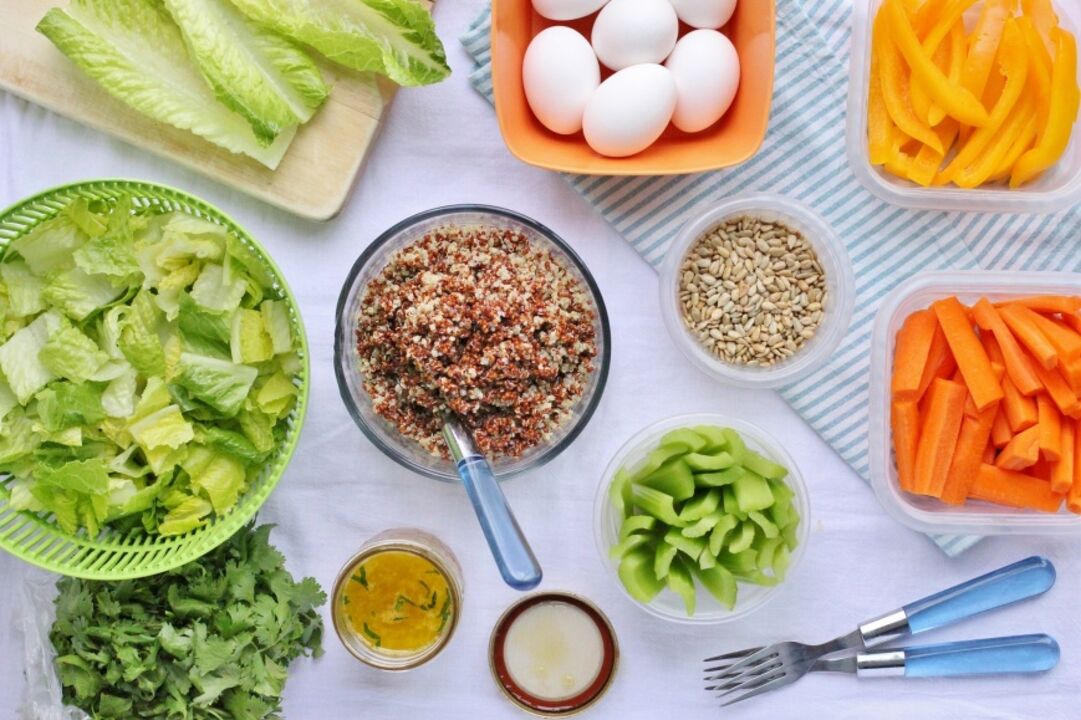
Pancreatitis is an inflammation of the pancreas. Pathology occurs in acute and chronic forms. The condition has a rather specific symptomatology: severe pain in the left hypochondrium, sometimes with a girdle character, fetal stools, nausea and vomiting.
Diet for pancreatic pancreatitis is one of the main areas of treatment for pathology. The patient's menu depends on the general state of health and the duration of the disease. It is necessary to adhere to medical nutrition for several months.
General principles
Nutrition for pancreatitis of the pancreas should be scarce. Basic principles of the diet:
- fractional nutrition - food must be taken five to six times a day in small portions;
- dishes should be covered, which facilitates the process of digestion of food;
- steaming and boiling are permitted cooking methods;
- fresh vegetables and fruit are strictly prohibited, i. e. not to be cooked;
- the permissible amount of salt per day does not exceed 5 grams;
- it is mandatory to take infusions and decoctions of rosehip berries;
- the dishes served at the table should be hot - hot and cold are contraindicated;
- Preservation, semi-finished products, fatty / fried / highly salty foods and products are strictly prohibited.
Deviation from the principles of dietary nutrition can stimulate the development of an attack of pancreatitis.
Approved and Prohibited Products
To reduce the production of pancreatic juice and reduce the burden on the inflamed gland, it is necessary to exclude it completely from the diet of the patient:
- Soups cooked in a rich broth of meat, fish and mushrooms, as well as complex soups - cabbage soup, pickles, borscht. Cold and dairy products are excluded.
- Bread - baked wheat / rye flour today, puff pastries and pastries, butter fried pies, tortillas.
- Fatty meats - pork, lamb, duck, goose - sausage, offal, canned food and smoked meat.
- Fish. Fatty, smoked, fatty varieties are prohibited.
- Milk and lactic acid products with a high fat content.
- Groats - millet, pearl barley, wheat, corn.
- Hard boiled and hard boiled eggs.
- Vegetables - turnip, radish, garlic, pepper, eggplant, cabbage, spinach.
- Sweets - jam, ice cream, fresh dates, grapes, bananas, figs.
- Spicy condiments.
- Coffee, strong brewed tea, coffee, soda, grape juice.
- Refractory fats - pork, beef, lamb.
When developing a menu for each day, it is necessary to take into account the recommendations of nutritionists and use only approved products. Six:
- dried loaf, biscuits, homemade biscuits;
- vegetarian soups with the addition of purified vegetables - potatoes, zucchini, pumpkin, carrots - noodles, semolina or oatmeal;
- lean meats - chicken, rabbit, turkey - in the form of steam cutlets, soufflé, dumplings, beef stroganoff;
- low fat fish species - pollock, carp, cod;
- cereals - oatmeal, semolina, rice - are used to make cereals, cassettes, puddings;
- low-fat milk and lactic acid products;
- steam omelet without yolks;
- vegetables - potatoes, zucchini, beets, pumpkin, cauliflower, carrots, green peas;
- sweet berries and fruits in the form of mousses, jellies, puddings, oven - baked apples;
- sauces - dairy and cooked in vegetable broth (when using flour, the latter is not salted);
- butter and vegetable oil;
- weak tea with lemon, still mineral water, rosehip decoction, juices diluted with water.
Diet for acute pancreatitis
If we talk about what type of diet is recommended for the patient with acute inflammation, then this is the 5P treatment table. During the first two or four days, a person is recommended to be completely hungry. Only liquid intake is allowed - a decoction of rosehip berries, Borjomi (without gas), weak tea. The patient then switches to nutrition therapy. The menu is allowed to include unsaturated dishes, but rich in carbohydrates.
An approximate list of dishes that can be included in the menu:
- steam omelette on proteins;
- meat soufflé;
- fish and meat dumplings;
- purified soups - rice and oatmeal - and vegetarian options;
- vegetable purees;
- mashed porridge - rice, buckwheat, oatmeal;
- apples in the form of jelly or mousse;
- fruit drinks from wild rose berries, cranberries, blackcurrants;
- add tea with milk;
- cottage cheese and dishes from it;
- cereal puddings.
Before you go to bed, you can offer kefir, yogurt, a glass of water with a tablespoon of honey dissolved in it, prunes and raisins.
Weekly strength program
When drafting a menu for a week, it must be remembered that the patient's diet should be changed. When developing a menu for a patient for the entire week, you can use the following suggestions.
Breakfast can be served with a salad of boiled beets and dried fruit compote, 150 grams of low-fat cottage cheese and a decoction of rosehip berries, steamless omelet without yolks, weak tea with biscuits, grated oatmeal and berry jelly, pumpkin porridge, rosehip drink, cheese with biscuits, rosehip broth, purified buckwheat porridge, compote.
Second breakfast: well-cooked rice porridge with steamed raisins, carrot salad with vegetable oil, apple stuffed with dried and oven-baked apricots, pumpkin and carrot puree, boiled beets, baked apple with sugar.
For lunch, vegetarian soups are allowed, for example, borscht, boiled fish garnished with well-cooked rice, boiled beef, cottage cheese casserole, steamed chicken cutlet, pasta with boiled minced meat, sauté. Snack options: approved fruit jelly, vegetable roll, fresh berry jelly, fruit pudding, oven baked potatoes, sandwiches with butter and a slice of cheese, beans.
Dinner: baked apple puree and low-fat yogurt, rice porridge with raisins, varenets, vinaigrette and yogurt, steamed cauliflower, a glass of yogurt, zucchini caviar, kefir, steamed omelet, fermented baked milk, rice porridge pudding and low-fat yogurt. .
Alternative dishes, you can create a "tasty" weekly menu that will give the sick person all the necessary substances, but at the same time the pancreas will receive a minimum nutritional load. You can find recipes for some dishes below.
Nutrition for the combined course of pancreatitis with gastritis or cholecystitis
If the development of cholecystitis is accompanied by the underlying disease, the menu is allowed to include the following:
- slim soups made from rice, oatmeal or semolina;
- mashed porridge, boiled in water, it is strictly forbidden to add milk and butter;
- vegetable juices, compotes;
- homemade white bread croutons;
- mashed cooked meat, fish;
- low fat cottage cheese.
With a combined course of pancreatitis and gastritis, mashed soups from oatmeal, rice and semolina should be included in the menu, to which you can add egg yolk and a little butter, mashed vegetables - potatoes, carrots, beets - with milk oradd cream, steam soufflés, cutlets, etc. dumplings from minced meat and fish.
Strict choice is recommended only during the acute period of the disease. After the condition stabilizes, the person switches to a diet recommended for chronic pancreatitis.
Aspects of the diet in childhood
The main principles of the diet in children are fragmentation, maximum grinding, compliance with the requirements of culinary processing, and variety. Small portions, if served frequently, prevent the baby from starving. In this case, the metabolic process is not violated.

The daily calorie intake is calculated based on the weight and age of the child. At the remission stage, the menu is allowed to include fresh vegetables and fruits (to a limited extent), but the basis of the diet is cereals with milk, minced meat dishes - chicken, turkey, meatless vegetable soups, cooked fish orbaked, cooked vegetables, dairy products. In small quantities and daily, it is allowed to give the child marshmallows, marmalade, jam, jam, honey.
Important!When introducing a new product into the diet, it is necessary to monitor the condition of the child.
Oidis
We offer you some recipes for dishes that can be prepared with diagnosed pancreatitis.
Beef pudding
Grind the cooked beef pulp (130 g) in a blender bowl. Add semolina (10 g), whipped egg whites, yolk and a little water (about 1/3 cup) to the powder. Add a few salt crystals. Grease the mold with oil, place the prepared minced meat and cook in a double boiler.
Fish dumplings
Grind lean fish (300 g) in a meat grinder. Grind a quarter of the dried loaf and pour the pieces with milk (100 ml). Squeeze the bread and mix it with the minced meat, add a few beaten proteins. Add salt and mix well. Form small balls with two spoons and boil them in salted water until offered. This will take about 15 minutes.
Vegetable puree soup
Cook until potatoes are fully cooked (2 pcs), Carrots and half a small zucchini. Drain the broth into a separate bowl, and chop the vegetables until the puree using a blender. Pour the puree with broth to the desired consistency and bring to a boil. Cook for 3 minutes. Serve hot with a tablespoon of sour cream in the soup.
Fish pudding
The fish carcass must be divided into two fillets. Boil the first one and rub through a sieve. Grind both in a meat grinder. Combine the two masses, add egg yolks, butter, salt. Glún. Divide into part and steam models.
Chicken soufflé
Grind cooked chicken in a meat grinder. Add egg yolks and butter to the minced meat. Mix well. Then gently whipped whites with the fluffy foam. Put the mass in a mold and steam.
Banana dessert
Dissolve 2 packets of gelatin according to instructions. Add 250 ml of natural yogurt. Steam a few peeled bananas and peaches. Place foil on the bottom of the plastic mold. Form the dessert into layers - biscuit crumbs, yogurt cream with gelatin, banana-peach puree. Alternate layers. Place the sweetness in the fridge to solidify the jelly.
Compliance with the principles of dietary nutrition in pancreatitis is a prerequisite for achieving continuous and long-term remission. The menu for patients with pancreatitis in adults and children, with the right approach to development, can be quite diverse and fully satisfy all the needs of the body.














































































